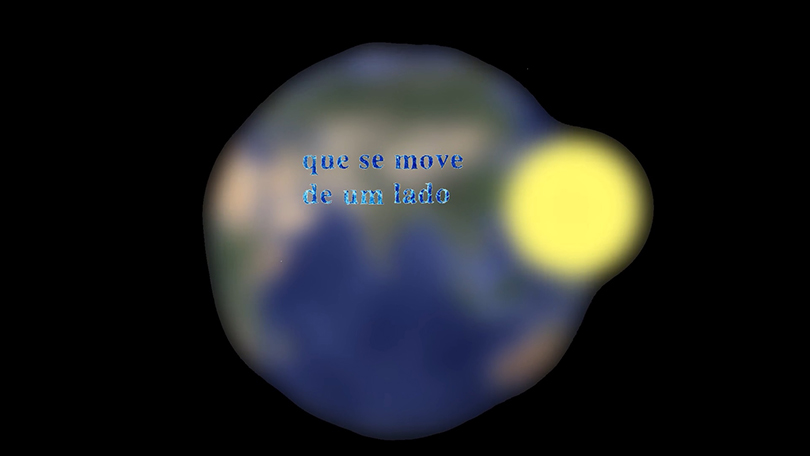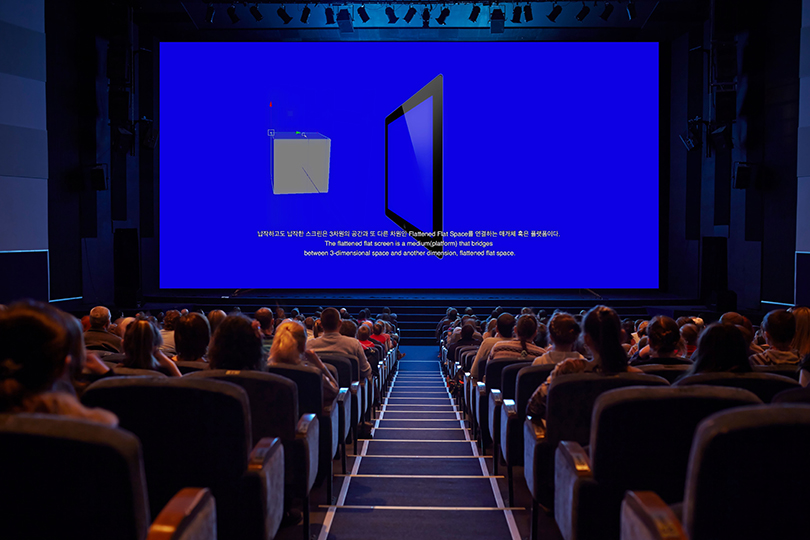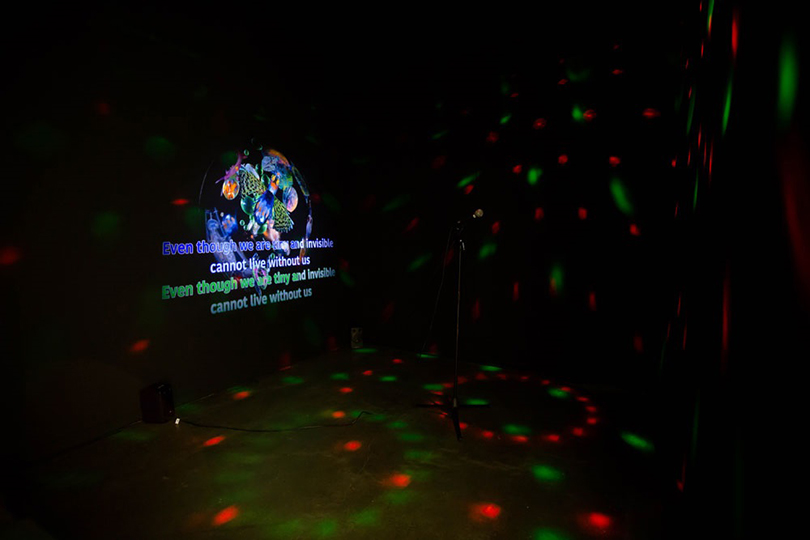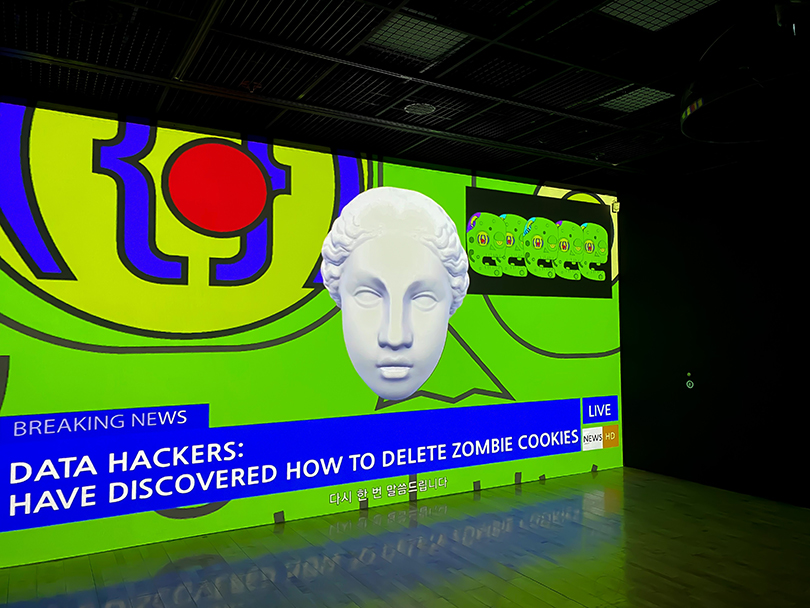
Suji Han began to exchange texts — like in a word chain game — with the Brazilian artist Daniela Avelar, whom she had met at a residency in Finland. Han was working on a series that explored the limits and possibilities of communication through language. The exchange first started like a game but developed into the sharing of genuine ideas, and this inspirational trading continued online after they returned home. 오늘 나는 단어 아마도로 하루를 시작할 것이다Hoje vou experimentar a palavra talvez part 2(2020) seems to summarize the tentative conclusion that this linguistic exchange eventually reaches. In the film, two speakers read each line in their own language. Unless the viewer knows both languages they cannot know whether these two sequences are actually translating each other. Han’s sentences delivered in Korean (like the lines of Avelar who is speaking in Portuguese) extend into questions about translation itself. The work creates a context surrounding translation, instead of delivering translated messages.

오늘 나는 단어 아마도로 하루를 시작할 것이다 hoje vou experimentar a palavra talvez(Part2), 2020, single channel video, sound, color, 3 min 34 sec. collaboration with Daniela Avelar. Image courtesy of the artist.
According to Han, translation is not merely “the process of transferring one language to another”; it involves the conversion of one form of data into another one. The issue of translation summons basic questions about the form of data. In her master’s thesis, Han defines data as “a phenomenon, memory, fact, or emotion of three-dimensional space being converted flat and saved.” There is no such action that strictly carries ‘the original meaning.’ The original form has to go through countless variations and distortions, conceptual as well as physical, before reaching the neurons of a receiver. This definition applies to digital data. The speaker claims that translation is therefore a process that paves a myriad of ‘new ways.’* Translation is organic in that new ideas are constantly generated, cultivated, transformed, and extinguished. A message does not ‘arrive’ to a receiver but ‘generates’ a new path of transmission.
The process of how the speaker’s words in the film reach the spectator’s neurons can also be ‘translation. Even if a receiver who is fluent in Korean hears the lines spoken in Korean, it cannot be the delivery of an ‘intact original’ that is free from transformation. Although the conversation was made in the same language, the linguistic sense of each speaker is unstably oscillating, and communication is initiated crossing in and out of the range of oscillation that overlaps multidimensionally. The speaker says it “embeds convention, institution, power, and hegemony.”* In other words, you are ‘translating’ this message written in English based on your sense and worldview.
The physical form of data also undergoes a radical variation. The body signal of the artist is delivered to a microphone through the air waves, transferred to an electric signal, and converted to digital data, simultaneously being saved in numbers fragmented by a binary system. Then it is transferred into air waves again by a device or speaker that ‘plays’ this series of numbers and stimulates the ear of receivers. Calling this series of technical, physical processes a ‘translation’ establishes a conceptual expansion. Under this extended reasoning, an intent to adopt an ‘essence’ intact is impossible. (This article that describes Han’s practice is also a process of creating a new thinking instead of adapting her original intention.) A message transforms its shape “like Ditto of Pokemon.”****(In this context, language is also a part of nature. It is a world dominated by an organic order where variants occur endlessly. Being infected with the coronavirus or the physiology of the immune system can also be a form of ‘translation.’ A language functions in correspondence with a natural order.)

Welcome to Flattened Flat Space, 2018-2019, single channel video, color, sound, 13 min. 31 sec. Image courtesy of the artist.
If all data must go through transformation, will transformation of externals be equated to the transformation of its essence? Or, is there ‘an essence’ that is never changed? Is a ‘message’ different if the language is different? How is communication possible with such transformation?
Under the theory of ‘poststructuralism’ in the humanities, language unfolds through infinite and organic flows instead of organizing a network of limited meanings. This is the way of reasoning in the late 20th century. Here, how a meaning is “blurred, vague, or ambiguous”*is a natural phenomenon. In fact, an ‘original meaning’ that is not transformed, modified, or distorted does not exist. What accompanies countless re-edits and variations, such as “expanding, deleting, copying, pasting, composing, distorting, twisting, cropping, and so on,**** is ‘translation.’ This is the form of all kinds of communication. How this principle works is closer to ‘mistranslation.’ Considering the degree of mistranslation that oscillates within the error range, we can only assume that ‘a message is delivered’ somehow. The message delivered to you through this article is also only roughly close to perhaps what is presumed to be my intention. Of course a precise message does not exist. That is nothing more than an association of possibilities made of fog.
Of course my intention of delivering this obsolete message taking the risk of transformation, modification, and distortion is not to support the humanities of the 20th century. Emerging thinking regarding universal ways of communication, regardless of the media or material, is interesting because it coincides with the era of digital technological advances. Looking back now, poststructuralism seems to exemplify the principle of digital technology. The way that technology works must be similar to the way a man thinks. Digital data continues to be re-edited and reprocessed. Actually, one quote from Han’s work above was not about ‘translation’ but a digital environment. Technologies like “expanding, deleting, copying, pasting, composing, distorting, twisting, cropping, and so on” are general functions of the digital. Premising ‘an original’ that is free from re-edits or reprocessing is never possible in both the digital world or poststructuralism. Supposedly “the start and end points do not exist in translation,”*it applies to the same in the digital. The digital is a language. It opens the grounds for massive ‘mistranslation.’ (In this context, the digital is also a part of nature. It is a world dominated by organic orders where variants occur endlessly. The digital functions in correspondence with the natural order.)
The digital reorganizes human thinking structurally. An interesting fact is that the digital goes even further to make a counter proposal about human thinking and the perspective of ‘translation.’ The meaning of translation adapted in the digital era indicates all practices to change the form of data. Every digital representation is, in other words, the process of translation and all translated figures resemble digital forms. Both are mirrors as well as expansions of human intelligence.
The critical issue here is that both language and the digital operate according to a huge organization and rules behind the dimension of visible representation. According to Han, it is more interesting to observe little severances, nodes, and new channels instead of understanding that overall, enormous pattern and achieving a systemized, comprehensive knowledge.* I believe it is because of the structural secret that lies in the little nodes. Observing them is similar to the practice of scientific investigation at the actual site where ‘mistranslation’ occurs. At the site, the evidence about the digital properties or performance principle of language awaits interpretation or misinterpretation. It is a site where “a phenomenon, memory, fact, or emotion in 3D space is converted flat and saved.” (The meaning of ‘save’ of course includes the possibility of transformation.) It is a matter of how an immaterial phenomenon, ‘meaning’, is conveyed into ‘physical’ 3D space. Can an invisible phenomenon like a spirit or mind really create an interface with the materiality of 3D space?
I cannot understand this secret. Instead, I can only think of one great physicist who left some insights.
Erwin Schrödinger identified the problem of consciousness by the interface between the physical dimensions and non-material worlds. How can physically conveyed signs interact with the non-material realm of consciousness? How can the air waves that run through neurons reach a non-material consciousness? Exploring the world of tiny particles, the physicist faced the solid wall of the non-material world. He declared, no matter how much science has accomplished, one can never acquire the knowledge of the point where material and non-material meet.
Individual men of the 21st century depended on the ‘approximate’ signification in each of their severed worlds. ‘Communication’ may be a conceptual defense mechanism against such necessary isolation.

Plankton and Bitplankton, 2019-2020, 2-channel video, 9 min 10 sec, color, sound, inflatable chair, RGB light. Image courtesy of the artist.

How to Be Forgotten: Escaping from the Digital Panopticon, 2020, single channel video, color, sound, 12 min 06 sec. Image courtesy of the artist.
Suji Han approaches where this severance occurs in the digital world, which is also an area of translation, to observe the way that ‘new channels’ are initiated. Floating inside the digital world, Han constantly seeks its thinking frame, instead of sinking into its politics or entertainment. The reason why Han’s artworks do not merely remain as vague observation or lame resistance against power relations in the digital and online setting is she asks questions through other corresponding systems. Han perceives the digital world through physics, marine biology, or neuroscience. Of course, the work cannot explain what the digital is through them. The artist does not seem to intend an overall understanding about the digital principle or function. The work cannot describe a microscopic dimension of a phenomenon or the operation of a brain through the digital. The analog worlds that are ‘translated’ by the digital world provide both insight and misconceptions at the same time. Just like how all translations proceed. The new channels are initiated by mistranslations. A digital plane as another dimension that expands the fourth dimension of space-time****, a Bit Plankton drifting in the enormous ocean of data***, and the zombi cookie that is not eliminated and survives like memories stored in the brain**are maybe the fragmentary ideas of mistranslation. Mistranslation is also an art of living in an expanding world. That would be a way to compromise with the solid wall that divides material and non-material. Mistranslation also gives wings for an imagination. Mistranslation is the way of connecting isolated worlds. (In that sense, mistranslation is also a part of nature. It is a world dominated by organic order where variants occur endlessly. Mistranslation functions in correspondence with natural orders.)
[Footnote]
*Hoje vou experimentar a palavra talvez Part 2(2020)
**How to be Forgotten(2020)
***Plankton & Bit Plankton(2019)
****Welcome to Flattened Flat Space(2019)
※ This content was first published in 『2021 SeMA Nanji Residency Program Catalogue』, and re-published here with the consent of SeMA Nanji Residency.
Hyun Suk Seo
Hyun-Suk Seo’s moving images and performance works as well as writings investigate how senses and space interact with and reconfigure each other. Heterotopia(2010-11), The Devine Prostitution of the Soul(2011), Stage Freight(2013), Heartlessly Autumn Wind(2013, Yokohama), From the Sea(2014,Tokyo), The Angel – Tenuously Named(2017), The Incomplete Ruins(with Gimhongseok, 2019), and Departures(2020), among other site-specific performance pieces and exhibitions, question and rework the boundaries of artistic experiences.
The first phases of his video projects on modernist architecture in the Asian postcolonial contexts have been shown at Gwangju Biennale(2011, 2018), Venice Architecture Biennale(2014, 2018), among others. He is the co-author of the books Impossible Dance(2020), Art of the Future(2016), Horror to the Extreme: Changing Boundaries in Asian Cinema(2009) and the co-editor of Ob.scene, the magazine for ‘things out of the scene’. He teaches cinema at Yonsei University.


